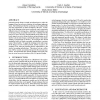273 search results - page 22 / 55 » Formal Implementation of Network Security Policies |
ACSAC
2006
IEEE
13 years 11 months ago
2006
IEEE
When an application reads private / sensitive information and subsequently communicates on an output channel such as a public file or a network connection, how can we ensure that ...
NDSS
1997
IEEE
13 years 11 months ago
1997
IEEE
This paper presents a model of hierarchical organization of Certification Authorities which can be applied to any open system network. In order to study the feasibility of the pro...
ESORICS
2007
Springer
14 years 1 months ago
2007
Springer
Abstract. From a security standpoint, it is preferable to implement least privilege network security policies in which only the bare minimum of TCP/UDP ports on internal hosts are ...
SACMAT
2006
ACM
14 years 1 months ago
2006
ACM
We introduce the concept, model, and policy-specific algorithms for inferring new access control decisions from previous ones. Our secondary and approximate authorization model (...
POPL
2005
ACM
14 years 7 months ago
2005
ACM
Network protocol design is usually an informal process where debugging is based on successive iterations of a prototype implementation. The feedback provided by a prototype can be...

